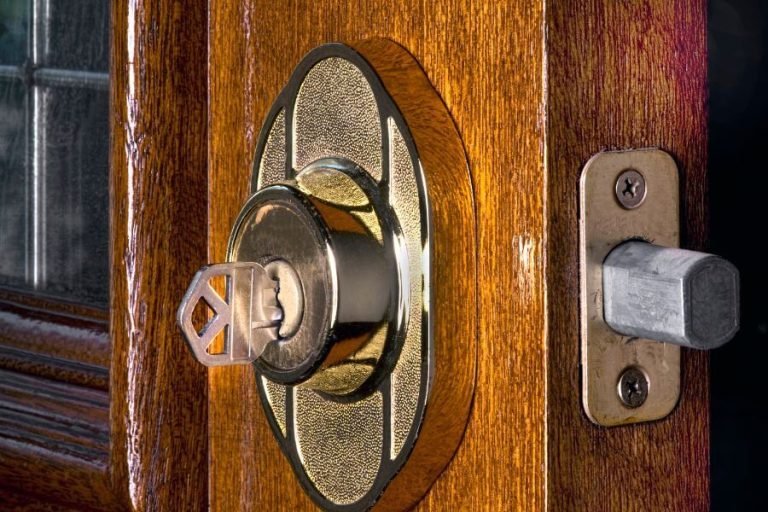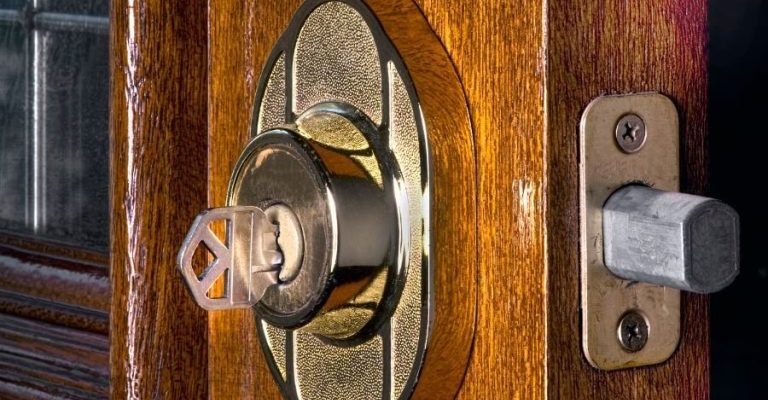
So why does this little metal bar suddenly stop working? And more importantly, what can you do about it—before you’re locked out or feel like you need a locksmith on speed dial? Let’s break down what the tailpiece does, common problems you’ll run into, and how you can troubleshoot (and maybe even fix) your deadbolt yourself—no advanced skills required.
What Is a Deadbolt Tailpiece, Anyway?
Let me explain: the deadbolt tailpiece is a flat or rectangular metal bar that runs from the lock cylinder (that part you turn with your key) all the way through to the latch mechanism hidden inside the door. Think of it as the bridge between your hand and the heavy-duty bolt that keeps your door secure. When you turn the key, the tailpiece rotates, which in turn slides the bolt in or out of the door frame.
Honestly, the tailpiece doesn’t get enough attention—until it stops working. Brands like Schlage, Kwikset, and Yale all have slight differences in their tailpiece designs, but the basic idea stays the same. Whether you’re using a traditional keyed lock or a modern smart deadbolt, the tailpiece acts as the mechanical link. If it bends, breaks, slips out of place, or doesn’t line up perfectly with the rest of the lock, the whole system fails.
If you think about it, your entire home’s security depends on this one thin metal piece doing its job properly. That’s why understanding how it works (and what can go wrong) is so important—especially if you’re trying to do some deadbolt troubleshooting.
Common Reasons the Tailpiece Doesn’t Engage the Lock
Here’s the thing: there aren’t a million reasons why a deadbolt’s tailpiece won’t engage, but the common ones can be surprisingly sneaky. Most often, you’ll run into trouble because something has shifted, bent, worn down, or wasn’t installed quite right in the first place.
- Misalignment: If the lock or cylinder isn’t lined up with the rest of the mechanism, the tailpiece might spin freely but not connect with the bolt. Even a slight shift can throw it off.
- Broken or Bent Tailpiece: Over time, repeated turning—especially if things are stiff—can cause the tailpiece to warp or snap. Some brands use softer metals, making this more likely.
- Wrong Tailpiece for the Lock: If someone replaced the cylinder or tried a universal part that isn’t quite right for your brand (like using a Schlage tailpiece in a Defiant lock), it might not reach or fit properly.
- Improper Installation: Sometimes, if you’ve recently rekeyed or replaced the lock, the tailpiece might not be seated correctly, or the lock cylinder isn’t tightened down enough for everything to line up.
- Internal Obstructions: Occasionally, debris, a jammed latch, or even a misplaced code disc (in the case of keyless or smart locks) can block the tailpiece from connecting with the bolt mechanism.
Recognizing these issues early is key. Usually, if your deadbolt feels “loose,” spins without moving the bolt, or only works intermittently, the tailpiece is crying out for attention.
How the Tailpiece Should Engage the Deadbolt
You might be wondering, “How is this supposed to work when everything’s fine?” In a healthy lock, turning the key or thumbturn rotates the cylinder, which turns the tailpiece. The end of the tailpiece fits into a slot or cam inside the deadbolt’s body, physically moving the bolt in and out.
Picture this: you insert the key, give it a turn, and feel a satisfying resistance as the mechanism moves. That’s the tailpiece slipping into its slot and doing the heavy lifting. In most locks—Kwikset, Schlage, Yale, and even many universal brands—the tailpiece shape and length must match the internal slot exactly. Too short, and it misses the slot. Too long, and it jams. A bent tailpiece might only sort-of catch, leaving you with a lock that sometimes works, sometimes doesn’t.
If you’re testing a lock on a desk before installing it, that “click” you feel when the bolt moves is the tailpiece engaging perfectly. No click? Something’s off.
When things aren’t lined up or the tailpiece isn’t the right fit, you’ll often feel a mushy or spinning action instead. That’s your sign there’s a mechanical disconnect inside.
How to Troubleshoot a Deadbolt Tailpiece That Won’t Engage
Ready for some hands-on deadbolt troubleshooting? Here’s a simple step-by-step way to check what’s wrong (no advanced locksmith skills required!):
- Check the key or thumbturn action: If it spins loosely, the tailpiece probably isn’t connecting to the bolt at all. If it’s stiff or jams, the tailpiece could be bent or something inside may be blocking movement.
- Remove the lock from the door: Unscrew both the interior and exterior halves. Pull them apart—carefully—while noting how the tailpiece connects to the rest of the mechanism.
- Compare the tailpiece to your deadbolt model: Look up your brand and model (Schlage, Defiant, Yale, etc.) online. The tailpiece should match or closely resemble what the brand recommends. If you see wear, bends, or breaks, that’s the likely culprit.
- Test the tailpiece action out of the door: With the lock disassembled, turn the key or thumbturn and watch how the tailpiece moves. Does it rotate smoothly and engage the bolt? If not, it might need a replacement.
- Double-check installation: When reinstalling, make sure the tailpiece seats firmly in its slot or cam. Don’t force it—if it doesn’t fit easily, something isn’t lined up or the part is wrong.
If you spot a clear issue—like a bent or broken tailpiece—replacing it is usually easier than you might think. Most hardware stores carry spares, and many locksmiths can provide the correct part for your lock’s brand.
Can You Fix or Replace a Deadbolt Tailpiece Yourself?
Honestly, swapping out a tailpiece is one of the less intimidating lock repairs. Most modern deadbolts (like the ever-popular Kwikset or standard Schlage models) are designed for some level of DIY repair. All you’ll need is a Phillips screwdriver, some patience, and maybe a replacement tailpiece.
The key is finding the right part—tailpieces can look similar but vary in length, shape, and thickness by brand and lock model.
- Remove the lock: Take the lock off the door and separate the cylinder from the bolt mechanism.
- Slide out the old tailpiece: Often, it’s held in with a small retaining clip or screw. Remove that, then pull the tailpiece straight out.
- Install the new tailpiece: Slide it into the cylinder, making sure it lines up with the lock’s slot and fits snugly.
- Reattach and test: Put the lock back together on the door, test for smooth operation, and make sure the bolt fully extends and retracts with each turn.
If you’re dealing with a smart lock or digital keypad model (like an August or Yale Assure), the tailpiece might have extra clips or require pairing for the code to sync with the hardware. In those cases, it’s smart to double-check the manufacturer’s manual just in case.
Is It the Tailpiece, or Something Else?
You might be thinking, “What if it’s not the tailpiece at all?” Good question. Sometimes, what feels like a tailpiece issue is actually something further down the line.
- Deadbolt Alignment: If your door sags or the bolt doesn’t line up with the strike plate, it can feel like the lock isn’t engaging—even though the tailpiece is fine.
- Worn Lock Mechanism: Internal pins, cams, or gears might be jammed, gritty, or broken. In older locks, a sticky or stubborn bolt is sometimes the real issue.
- Smart Lock Battery Issues: Low or dead batteries can prevent the lock from responding when you enter a code or use a remote—not a tailpiece problem, but easy to confuse with one.
Whenever you’re troubleshooting, it pays to check the whole system. Make sure the bolt slides easily when you operate it by hand (with the lock off the door). If it doesn’t, you’ll need to clean or replace other internal parts.
What to Do If Replacement Parts Aren’t Available
Let me be real: sometimes you just can’t find an exact-match tailpiece for your lock—especially if it’s a rare brand or an older model. In these cases, you have a few options.
- Universal Tailpieces: Hardware stores often sell “universal” deadbolt tailpieces, which you can cut or bend to fit. Just be careful—universal isn’t always perfect, and you might need to trim or tweak the part.
- Swap for a New Deadbolt: If your lock is outdated or you can’t find a replacement, swapping the whole deadbolt is usually the best bet. Pick a quality model (like Schlage, Kwikset, or Yale), and follow the manufacturer’s install instructions.
- Consult a Locksmith: Some problems just need a pro. A locksmith can often repair or fabricate a replacement tailpiece, especially for vintage or specialty locks.
Whatever you do, avoid forcing a part that doesn’t fit—this can jam the lock for good or strip the internal cam.
How to Prevent Tailpiece Problems in the Future
After all the frustration of a tailpiece not engaging the lock, a little prevention can save a ton of hassle next time. Here’s what actually works:
- Lubricate the Lock: Once a year, spray a bit of lock lubricant (not WD-40!) into the keyway. This helps keep the tailpiece and internal mechanism moving smoothly.
- Check Alignment Regularly: If your door sags, sticks, or swells with the weather, the deadbolt can get misaligned. Tighten the door hinges or move the strike plate to maintain proper fit.
- Avoid Excess Force: If the deadbolt resists, don’t keep cranking the key or thumbturn. That’s a quick way to bend or snap the tailpiece.
- Stick with Quality Brands: Some off-brand deadbolts have flimsy tailpieces. If you’re replacing or upgrading, it’s worth spending a bit more for a better-made lock.
Most importantly, if you ever take apart your deadbolt (for rekeying, cleaning, or repair), double-check how the tailpiece goes back together. Snap a photo before you start—that way you’ll have a reference if things get confusing.
Final Thoughts: Keep Your Deadbolt Strong (and Spinning!)
At the end of the day, when your deadbolt’s tailpiece isn’t engaging the lock, it’s usually a fixable problem—not a home security crisis. The tailpiece is small, but it’s the whole point of a deadbolt: connecting you (via key or code) to a secure, locked door. Whether yours needs a quick adjustment, a swap for a better-fitting part, or a little TLC, a bit of understanding goes a long way.
If you’ve taken the time to check alignment, confirm the parts, and gently test your repairs, your deadbolt should be back to working smoothly. That satisfying “click” when you lock up? That’s your lock doing what it was built to do—no locksmith required.
